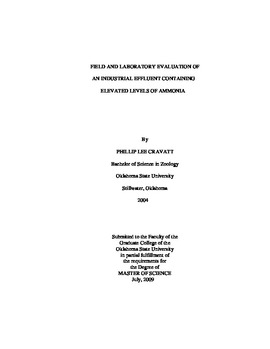| dc.contributor.advisor | Bidwell, Joseph R. | |
| dc.contributor.author | Cravatt, Phillip Lee | |
| dc.date.accessioned | 2014-04-15T22:31:38Z | |
| dc.date.available | 2014-04-15T22:31:38Z | |
| dc.date.issued | 2009-07-01 | |
| dc.identifier.uri | https://hdl.handle.net/11244/9551 | |
| dc.description.abstract | This study evaluated the effects of an industrial wastewater effluent that contains varying levels of ammonia on the biota in a reach of the Verdigris River in Oklahoma. This investigation was undertaken using both laboratory toxicity tests, as well as field site monitoring including community assessments and in situ techniques, water quality monitoring, macroinvertebrate and fish community sampling and an in situ zebra mussel (Dreissena polymorpha) study. A series of 48-hr laboratory bioassays using the fathead minnow (Pimephales promelas) were performed in unadjusted and pH manipulated effluent and laboratory water (pH 8.5 and 9.0). Additionally ammonia levels (total) were adjusted to 10, 20 and 30 mg NH3-N/L, for another series of toxicity tests with both unadjusted and manipulated test waters. Unadjusted (pH) effluent at all ammonia levels showed no toxicity until total ammonia levels reached 30 mg NH3-N/L (65.2%) whereas at pH 8.5 LC50 values at 20 and 30 mg NH3-N/L total ammonia were 58.5% and 38.1%, respectively. The largest effect on toxicity was observed in the effluent at pH 9.0 with LC50 values of 66.4% at 10mg/L, 23.1% at 20 mg/L and 16.2% at 30 mg/L total ammonia. The ammonia solutions were generally more toxic to the fathead minnows than the effluent samples with similar ammonia concentrations, which could be an indication that the effluent matrix ameliorated ammonia toxicity. In the on-site field study, there were no significant differences at the effluent outflow site compared with sites up and down-river on the macroinvertebrate communities, zebra mussel growth and wet: dry weight, although the effluent did attract more fish in the immediate vicinity of the outflow (not significant). Overall, the results from the study indicate the effluent is not having any significant adverse effects on the receiving system. | |
| dc.format | application/pdf | |
| dc.language | en_US | |
| dc.publisher | Oklahoma State University | |
| dc.rights | Copyright is held by the author who has granted the Oklahoma State University Library the non-exclusive right to share this material in its institutional repository. Contact Digital Library Services at lib-dls@okstate.edu or 405-744-9161 for the permission policy on the use, reproduction or distribution of this material. | |
| dc.title | Field and Laboratory Evaluation of an Industrial Effluent Containing Elevated Levels of Ammonia | |
| dc.type | text | |
| dc.contributor.committeeMember | Storm, Daniel E. | |
| dc.contributor.committeeMember | Dzialowski, Andrew R. | |
| osu.filename | Cravatt_okstate_0664M_10432.pdf | |
| osu.college | Agricultural Sciences and Natural Resources | |
| osu.accesstype | Open Access | |
| dc.description.department | Environmental Sciences Program | |
| dc.type.genre | Thesis | |
